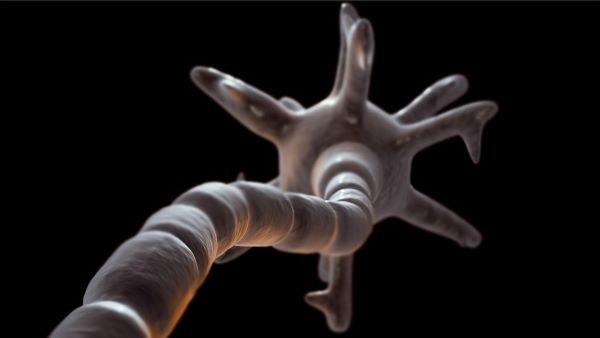May is Guillain-Barre Syndrome and Chronic Inflammatory Demyelinating Polyneuropathy awareness month so the next two blogs will be discussing these conditions.
Let’s start with GBS or Guillain-Barre Syndrome.

Healthy nerve cell with intact Myelin Sheath
What is Guillain-Barre Syndrome
GBS is a rare lower motor neuron disorder where your body’s immune system, which usually only attacks invading organisms, mistakenly attacks your nerves.
The cause of GBS is unknown, but two thirds of people who have GBS report symptoms of infection in the six weeks prior to GBS. GBS can be difficult to diagnose in its early stages as its symptoms can be similar to many other neurological disorders and can vary from person to person. It’s important to speak to a medical professional if you are experiencing any of the symptoms discussed below.
What are the symptoms?
The first symptoms are generally weakness and tingling in your feet and legs spreading to your upper body or arms. In 10% of cases, symptoms can begin with the arms or the face. As the syndrome progresses, muscle weakness can evolve into paralysis.
Other signs and symptoms can include:
- Rapid heart rate
- Trouble breathing
- Difficulties walking
- High or low blood pressure
- Double vision or trouble moving eyes
- Severe pain that may be worse at night
- Problems with bladder control or bowel function
- Pins and needling in fingers, toes, ankles, or wrists
- Difficulties with facial movement, and swallowing
- Weakness in your legs that spreads to the upper body
There is no cure for GBS but several treatments can help manage symptoms and reduce the duration of illness.
The good news is that most people recover from GBS with over % of people being able to walk about six months1. Unfortunately, up to 20% of people will be left with a severe disability 2, 3.
How can physiotherapy support people with Guillain Barre Syndrome?
Physiotherapists have a role in management of people with GBS before and during recovery. The aims of physiotherapy management include:
- Regain independence in everyday tasks
- Retrain normal movement patterns
- Improve balance and coordination
- Maintain clear airways and prevent lung infection
- Prevention of pressure sores
- Practices to help cope with fatigue and regain strength
- Advice around assistive devices such as walkers and wheelchairs to facilitate safe and effective mobility
You can find out more about GBS and GBS/CIPD awareness month at https://www.gbs-cidp.org/
If you are experience ongoing symptoms after having GBS and would like physiotherapy support, you can email Sunshine Coast Neuro Rehab on admin@scnr.com.au or call us on (07) 5448 1155.
Neve Cavanagah
1 Nguyen TP, Taylor RS. Guillain Barre Syndrome. [Updated 2021 Jul 10]. In: StatPearls [Internet]. Treasure Island (FL): StatPearls Publishing; 2022 Jan-.
2 Rajabally YA, Uncini AOutcome and its predictors in Guillain–Barré syndromeJournal of Neurology, Neurosurgery & Psychiatry
3 Kuwabara S. Guillain-Barré syndrome: epidemiology, pathophysiology and management. Drugs. 2004;64(6):597-610.
